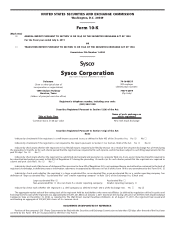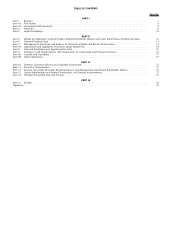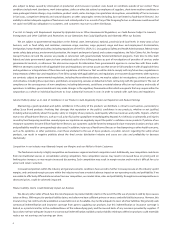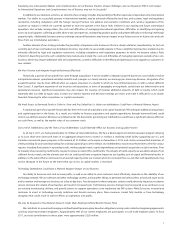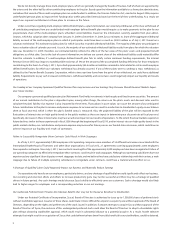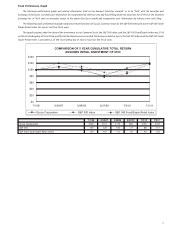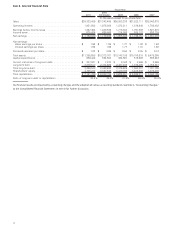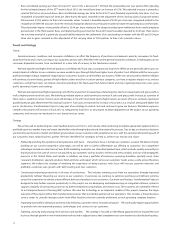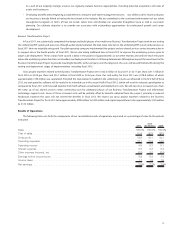Sysco 2011 Annual Report Download - page 32
Download and view the complete annual report
Please find page 32 of the 2011 Sysco annual report below. You can navigate through the pages in the report by either clicking on the pages listed below, or by using the keyword search tool below to find specific information within the annual report.We do not directly manage these multi-employer plans, which are generally managed by boards of trustees, half of whom are appointed by
the unions and the other half by other contributing employers to the plan. Based upon the information available to us from plan administrators,
we believe that several of these multi-employer plans are underfunded. In addition, the Pension Protection Act, enacted in August 2006, requires
underfunded pension plans to improve their funding ratios within prescribed intervals based on the level of their underfunding. As a result, we
expect our required contributions to these plans to increase in the future.
Under current law regarding multi-employer defined benefit plans, a plan’s termination, our voluntary withdrawal, or the mass withdrawal of
all contributing employers from any underfunded multi-employer defined benefit plan would require us to make payments to the plan for our
proportionate share of the multi-employer plan’s unfunded vested liabilities. Based on the information currently available from plan admin-
istrators, which has valuation dates ranging from January 31, 2009 to December 31, 2009, Sysco estimates its share of the aggregate withdrawal
liability on most of the multi-employer plans in which it participates could have been as much as $200.0 million as of July 2, 2011 based on a
voluntary withdrawal. This estimate excludes plans for which Sysco has recorded withdrawal liabilities. The majority of the plans we participate in
have a valuation date of calendar year-end. As such, the majority of our estimated withdrawal liability results from plans for which the valuation
date was December 31, 2009; therefore, our estimated liability reflects the effects of the fair value of the plans’ assets and projected benefit
obligations as of that date. Due to the lack of current information, we believe our current share of the withdrawal liability could materially differ
from this estimate. In addition, if a multi-employer defined benefit plan fails to satisfy certain minimum funding requirements, the Internal
Revenue Service (IRS) may impose a nondeductible excise tax of 5% on the amount of the accumulated funding deficiency for those employers
contributing to the fund. As of July 2, 2011, Sysco had approximately $42.4 million in liabilities recorded in total related to certain multi-employer
defined benefit plans for which our voluntary withdrawal has already occurred. If any of these plans were to undergo a mass withdrawal, as
defined by the Pension Benefit Guaranty Corporation, within a two year time frame from the point of our withdrawal, we could have additional
liability. Requirements to pay such increased contributions, withdrawal liability, and excise taxes could negatively impact our liquidity and results
of operations.
Our Funding of our Company-Sponsored Qualified Pension Plan may Increase and our Earnings May Decrease Should Financial Markets Experi-
ence Future Declines
Our company-sponsored qualified pension plan (Retirement Plan) holds investments in both equity and fixed income securities. The amount
of our annual contribution to the plan is dependent upon, among other things, the returns on the plan’s assets and discount rates used to
calculate the plan’s liability. Our expense is also impacted by these items. Fluctuations in asset values can cause the amount of our anticipated
future contributions to the plan to increase and pension expense to increase and can result in a reduction to shareholders’ equity on our balance
sheet at fiscal year-end, which is when this plan’s funded status is measured. Also, the projected liability of the plan will be impacted by the
fluctuations of interest rates on high quality bonds in the public markets as these are inputs in determining our discount rate at fiscal year-end.
Specifically, decreases in these interest rates may have an adverse impact on our results of operations. To the extent financial markets experience
future declines similar to those experienced in fiscal 2008 through the beginning of fiscal 2010, and/or interest rates on high quality bonds in the
public markets decline, our contributions and pension expense may increase for future years as our funded status decreases, which could have an
adverse impact on our liquidity and results of operations.
Failure to Successfully Renegotiate Union Contracts Could Result in Work Stoppages
As of July 2, 2011, approximately 7,800 employees at 52 operating companies were members of 55 different local unions associated with the
International Brotherhood of Teamsters and other labor organizations. In fiscal 2012, 21 agreements covering approximately 2,000 employees
have expired or will expire. Since July 2, 2011, two contracts covering 85 of the approximately 2,000 employees have been renegotiated. Failure of
our operating companies to effectively renegotiate these contracts could result in work stoppages. Although our operating subsidiaries have not
experienced any significant labor disputes or work stoppages to date, and we believe they have satisfactory relationships with their unions, a work
stoppage due to failure of multiple operating subsidiaries to renegotiate union contracts could have a material adverse effect on us.
A Shortage of Qualified Labor Could Negatively Impact our Business and Materially Reduce Earnings
Our operations rely heavily on our employees, particularly drivers, and any shortage of qualified labor could significantly affect our business.
Our recruiting and retention efforts and efforts to increase productivity gains may not be successful and there may be a shortage of qualified
drivers in future periods. Any such shortage would decrease Sysco’s ability to effectively serve our customers. Such a shortage would also likely
lead to higher wages for employees and a corresponding reduction in our net earnings.
Our Authorized Preferred Stock Provides Anti-Takeover Benefits that may not be Viewed as Beneficial to Stockholders
Under our Restated Certificate of Incorporation, Sysco’s Board of Directors is authorized to issue up to 1,500,000 shares of preferred stock
without stockholder approval. Issuance of these shares could make it more difficult for anyone to acquire Sysco without approval of the Board of
Directors, depending on the rights and preferences of the stock issued. In addition, if anyone attempts to acquire Sysco without approval of the
Board of Directors of Sysco, the existence of this undesignated preferred stock could allow the Board of Directors to adopt a shareholder rights
plan without obtaining stockholder approval, which could result in substantial dilution to a potential acquirer. As a result, hostile takeover
attempts that might result in an acquisition of Sysco, that could otherwise have been financially beneficial to our stockholders, could be deterred.
8



